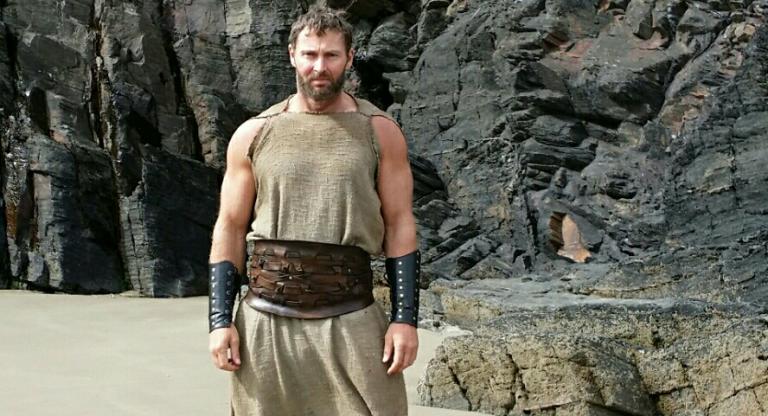In the Name of Ben-Hur is what some have called a “mockbuster”. It is a low-budget direct-to-DVD movie that was made to piggyback on the success of a mainstream film by telling a similar story with a similar title while the mainstream film was still in theatres.
It was produced by The Asylum, a company that specializes in such films. One of their first big successes was an adaptation of H.G. Wells’s The War of the Worlds that came out in 2005, the same year as Steven Spielberg’s big-budget version. Since then they have made films with titles like Transmorphers, The Day the Earth Stopped, and so on.
So when Timur Bekmambetov directed his big-budget remake of Ben-Hur four years ago, The Asylum put out its own version as well. But instead of producing a rival adaptation of Lew Wallace’s 1880 novel, they made a sort of sequel — and in doing so, they actually took into account one or two details from the novel that every other film has ignored.
To wit: all of the previous adaptations of Ben-Hur have basically ended with the death of Jesus and with Judah Ben-Hur’s conversion to Christianity, or at least to a sort of quasi-Christian humanism or pacifism — but the original novel ended decades later, with Judah going to Rome and using his wealth to help the Christians in the catacombs, who were hiding from Nero there during the persecution that began in AD 64.
Amazingly, In the Name of Ben-Hur embraces this oft-neglected aspect of the book. It takes place during the reign of Nero, and when we first meet Judah — who is now living in Lusitania for some reason — he mentions his experience in the catacombs. So this story takes place after the epilogue in Wallace’s novel but before Nero’s death in AD 68.
Presumably, The Asylum set the story in this time and place partly for budgetary reasons: they couldn’t afford the sea battle or chariot race of all the best-known versions of Ben-Hur, so they had to tell a smaller story, something that could be limited to skirmishes in a forest or short chases on a beach. Also, by setting the story so far from the time and place of the New Testament, they got to sidestep the novel’s more religious elements.
Of course, the fact that this film takes place when it does should mean that Judah is in his 60s or thereabouts by now, but he definitely seems younger than that. (Adrian Bouchet, the actor who plays him, was born in 1972 and turned 44 the year the film came out.)
The movie’s sense of time is flexible in other ways, too: one female warrior who fights for the Romans says she fought in the Battle of the Teutoburg Forest, a rare major defeat for the Romans that took place in AD 9; that was over half a century before this movie takes place, and this woman doesn’t look remotely old enough to have been there then.
It’s all very reminiscent of how the 1935 version of The Last Days of Pompeii had Pontius Pilate visiting Pompeii just before the volcano destroyed that city in AD 79, half a century after Pilate executed Jesus. But hey, at least it still takes place in the first century! Everything that happened back then happened more or less at the same time, right?
The movie itself concerns Judah’s efforts to help an anti-Roman resistance movement in Lusitania (i.e. modern Portugal). The Romans running the place have decided to kidnap some women and send them to Nero as concubines, and the locals try to get Judah, who is still famous from his days in the arena, to help them fight back. (It is implied that he was more of a gladiator than a charioteer.) Judah resists at first, by asserting the virtues of peace and forgiveness, but he soon decides to teach them how to fight after all.
And so, while the film has one or two hints of Judah’s Christianity, it basically sets them aside in favour of good old-fashioned fight scenes — which is in stark contrast to most of the earlier Ben-Hur films, which were all about Judah’s movement away from armed resistance to the Roman Empire. Judah even comes up with a peculiar justification for his willingness to kill people: he says it’s okay for him to do it as long as he lets his victims decide whether they will be killed. So it’s really all their fault if they die, I guess.
We do see Judah pray to the “Almighty Lord” at one point early on, when he’s still clinging to the idea of peace, but there isn’t much evidence of his faith beyond that. Indeed, he seems thoroughly paganized at times; when he dispatches one of his Roman enemies while the enemy is still talking, he says, “Tell it to the oarsman,” which is a nice reference to pagan mythology (i.e. to Charon, who takes the souls of the dead across the river Styx), but is not the sort of thing you’d expect a Jew, Christian or otherwise, to say.
There is one other reference to the novel that comes up very late in the film, and I’ll avoid getting into the spoilerific details. But suffice it to say that one character is revealed to be the grandson of another character who, as far as I can recall, did not have any offspring in the original story. What’s more, it is implied that the grandfather lived much longer than he did in the novel (and in some of the other films). So there are some continuity issues there, too, if one is inclined to take the movie seriously enough to wade into that.
One other weird thing: The blurb on the DVD cover says: “A gladiator escapes his imprisonment in a Roman arena in A.D. 171. As he tries to make it to Hadrian’s Wall and freedom he becomes a folk hero to those who have been oppressed by the Roman Empire.” The blurb on Amazon Prime, which is where I watched the film, is similar: “A young gladiator enslaved in the Roman arena in 171 A.D. escapes by chariot towards the freedom of Hadrian’s Wall. Fighting centurions and mercenaries along the way, he becomes a folk hero for all those struggling to fight Roman oppression.”
The “folk hero” stuff may match what happens in the movie, more or less. But I have no idea where the business about Hadrian’s Wall or the late 2nd century is coming from. (Full marks to the DVD cover, by the way, for putting “A.D.” before the year number, which is the correct way to do it.) The film itself is clearly set in continental Europe, whereas Hadrian’s Wall is across the Channel, in northern England. And the film is clearly set during the reign of Nero, who ruled in the mid-1st century, from AD 54 to AD 68.
Anyway. I have never seen any of The Asylum’s other films (except for Sharknado), but I had to see this one for obvious reasons. In the Name of Ben-Hur was obviously produced to cash in on the fact that there was a brand-new version of Ben-Hur coming to the big screen in 2016, but the big-screen movie was such a big flop that I can only wonder how it affected this film’s revenues, compared to The Asylum’s other productions.














